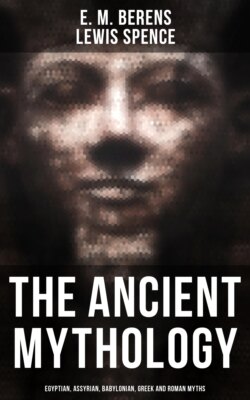Читать книгу The Ancient Mythology: Egyptian, Assyrian, Babylonian, Greek and Roman Myths - Lewis Spence - Страница 61
На сайте Литреса книга снята с продажи.
Tammuz and Ishtar
ОглавлениеThe myth of Tammuz is one of high antiquity, dating possibly from 4000 B.C. or even earlier. Both Tammuz and Ishtar were originally non-Semitic, the name of the former deity being derived from the Akkadian Dumu-zi, 'son of life,' or 'the only son,' perhaps a contraction of Dumu-zi-apsu, 'offspring of the spirit of the deep,' as Professor Sayce indicates. The 'spirit of the deep' is, of course, the water-god Ea, and Tammuz apparently typifies the sun, though he is not, as will presently be seen, a simple solar deity, but a god who unites in himself the attributes of various departmental divinities. An ancient Akkadian hymn addresses Tammuz as "Shepherd and lord, husband of Ishtar the lady of heaven, lord of the underworld, lord of the shepherd's seat;" as grain which lies unwatered in the meadow, which beareth no green blade; as a sapling planted in a waterless place; as a sapling torn out by the root. Professor Sayce identifies him with that Daonus, or Daos, whom Berossus states to have been the sixth king of Babylonia during the mythical period. Tammuz is the shepherd of the sky, and his flocks and herds, like those of St Ilya in Slavonic folk-lore, are the cloud-cattle and the fleecy vapours of the heavens.
Ishtar has from an early period been associated with Tammuz as his consort, as she has, indeed, with Merodach and Assur and other deities. Yet she is by no means a mere reflection of the male divinity, but has a distinct individuality of her own, differing in this from all other Babylonian goddesses and betraying her non-Semitic origin. The widespread character of the worship of Ishtar is remarkable. None of the Babylonian or Assyrian deities were adopted into the pantheons of so many alien races. From the Persian Gulf to the pillars of Hercules she was adored as the great mother of all living. She has been identified with Dawkina, wife of Ea, and is therefore mother of Tammuz as well as his consort. This dual relationship may account for that which appears in later myths among the Greeks, where Smyrna, mother of Adonis, is also his sister. Ishtar was regarded sometimes as the daughter of the sky-god Anu, and sometimes as the child of Sin, the lunar deity. Her worship in Babylonia was universal, and in time displaced that of Tammuz himself. The love of Ishtar for Tammuz represents the wooing of the sun-god of spring-time by the goddess of fertility; the god is slain by the relentless heat of summer, and there is little doubt that Ishtar enters Aralu in search of her youthful husband. The poem we are about to consider briefly deals with a part only of the myth—the story of Ishtar's descent into Aralu. It opens thus: "To the land of No-return, the region of darkness, Ishtar, the daughter of Sin, turned her ear, even Ishtar, the daughter of Sin, turned her ear, to the abode of darkness, the dwelling of Irkalla, to the house whose enterer goes not forth, to the road whence the wayfarer never returns, to the house whose inhabitants see no light, to the region where dust is their bread and their food mud; they see no light, they dwell in darkness, they are clothed, like the birds, in a garment of feathers. On the door and the bolt hath the dust fallen." The moral contained in this passage is a gloomy one for mortal man; he who enters the dread precincts of Aralu goes not forth, he is doomed to remain for ever in the enveloping darkness, his sustenance mud and dust. The mention of the dust which lies "on door and bolt" strikes a peculiarly bleak and dreary note; like other primitive races the ancient Babylonians painted the other world not definitely as a place of reward or punishment, but rather as a weak reflection of the earth-world, a region of darkness and passive misery which must have offered a singularly uninviting prospect to a vigorous human being. The garment of feathers is somewhat puzzling. Why should the dead wear a garment of feathers? Unless it be that the sun-god, identified in some of his aspects with the eagle, descends into the underworld in a dress of feathers, and that therefore mortals who follow him must appear in the nether regions in similar guise. The description above quoted of the Babylonian Hades tallies with that given in dream to Eabani by the temple-maiden Ukhut (Gilgamesh epic, tablet VII).
